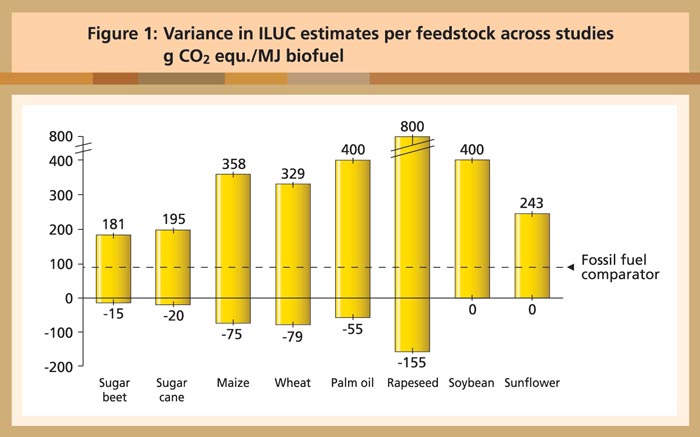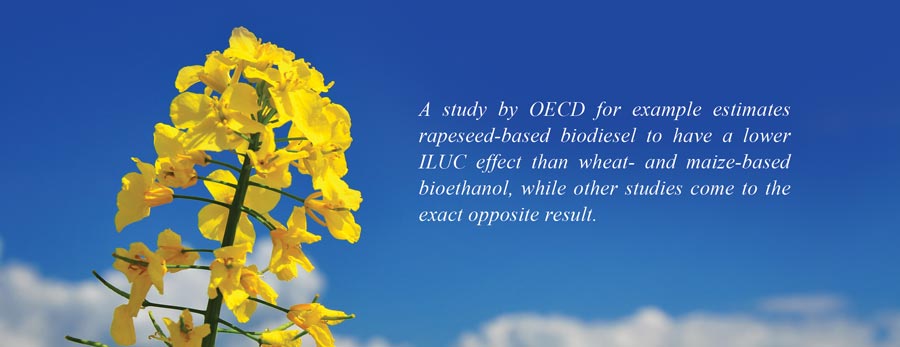



Its effect differs case by case
March, 2019 in Issue 1 - 2019, Cover Story
The use of biofuels in Europe has been promoted at European Union (EU) level through several Directives with the aim of making the transport sector more sustainable, but has also been associated with pressure on land, leading to the conversion of carbon-rich land (e.g. deforestation). The concern is that biofuels may not reduce emissions as much as hoped, since they can spur increased emissions elsewhere through land use change, either directly or indirectly.
Direct land use change (DLUC) is when cropland is expanded for biofuel feedstock production, e.g. when a forest in Europe is cut down in order to grow wheat for biofuel production there. DLUC is observable and can be monitored; in case of non-compliance with rules (e.g. forest conservation rules), authorities can enforce penalties. Indirect land use change (ILUC) also describes conversion of land to cropland, but caused indirectly through displacement of production in other locations. If, for example, European wheat has been used for food production before, but is now used for bioethanol instead, this could give rise to wheat production (or the production of a substitute crop) elsewhere in the world due to increasing wheat prices. The land that may be converted to cropland for this purpose is the indirect land use change effect of the wheat-based ethanol.
While ILUC can be just as real as DLUC, it cannot be monitored in the same way. It is practically impossible to establish a clear, quantifiable causality between the production of biofuel crops and the ultimate land use change somewhere else in the world, since the latter is influenced by a countless amount of circumstances. In the attempt to estimate the ILUC effect of biofuels anyway complex economic models are used, which need to make assumptions regarding a large number of highly uncertain parameters as explained with some examples below.
Now in 2019, the ILUC discussion is back on the political agenda. The EU’s recast of the Renewable Energy Directive to 2030 (RED II) includes an updated target for renewable energy used in transport of 14% with biofuels playing a major role in achieving this target. However, RED II limits the extent to which biofuels from feedstocks associated with high ILUC can contribute to the target of 14%: a Delegated Act is being prepared by the European Commission in an attempt to determine ‘high risk’ or ‘low risk’ biofuels, based at least in part on ILUC. Biofuels associated with high ILUC may not exceed 2019 consumption levels, and are then to be phased out to zero by 2030. As of today, there is no clear definition of what high ILUC vs low ILUC risk biofuels are, but the Commission is required to set criteria for classifying this in 2019. This is the role of the Delegated Act.
While we acknowledge the overall ambition, we conclude that the concept of ILUC should not be a part of such regulation. The Delegated Act, if it attempts to base regulatory decisions on ‘high risk’ ILUC, would be outside of the current scientific consensus. The reason is that there is no scientific consensus about the ILUC effects of different biofuels that would support such a classification; if it is done anyway, it is likely that it will do more harm than good.
The ILUC effect, or ILUC factor, is a term for the estimated emissions due to indirect land use change expressed in grams of CO2 equivalents per megajoule of biofuel (g CO2 equ./MJ biofuel). A negative ILUC factor means that the production of the biofuel entails an overall net reduction in greenhouse gas emissions. Positive ILUC factors mean positive net emissions, but those can still be lower than for fossil fuels. The fossil fuel comparator as determined by the Commission in RED II for the transport sector is 94 g CO2 equ./MJ;2 this means that the use of biofuels with a lower (higher) ILUC factor will entail a net decrease (increase) in emissions.
Indeed, we are currently far away from a consensus about the ILUC effect of different biofuels. The researchers’ attempts to model the ILUC effects of biofuel production have resulted in estimates that vary enormously and do not allow for any robust conclusions. The predicted ILUC factor across models for wheat-based bioethanol, for example, ranges from -79 to 329 g CO2 equ./MJ biofuel (Figure 1). This means that its ILUC effect lies somewhere between an emission reduction by 184% and an emission increase by 250% compared to using fossil fuel. The other feedstocks feature similarly large ranges in estimates. It becomes clear that no meaningful conclusions can be drawn from estimates with such variation.

Note: Break in continuity in the y-axis.
Source: European Commissions (2017) and Copenhagen Economics (2014)
2See European Commission (2017), Annex V part C, point 19.
Substantial variation can be observed not only between, but even within models. A study from 20153, for example, yields ILUC factors between -20 and 175 for sugar cane, and between 10 and over 400 for soybean. This illustrates how uncertain and complex ILUC modelling is: even when using the same modelling approach and overall assumptions, the ILUC effect is difficult to narrow down.
As a consequence of the large variation within and between models, no robust conclusions can be made about the relative ILUC effects. There is no clear consensus regarding the relative ranking of feedstocks in terms of ILUC effects. A study by OECD4 for example estimates rapeseed-based biodiesel to have a lower ILUC effect than wheat- and maize-based bioethanol, while other studies5 come to the exact opposite result.

This large variance in ILUC estimates is not a surprise. The results will vary depending on which modelling approach is taken, and which assumptions are made.6 To arrive at an ILUC estimate, the model needs to go through several steps, all of which contain new assumptions and uncertainties. An example is whether and how by-products of biofuel feedstock production are included in the model. By-products are parts of the harvest that cannot be used for biofuels, but for other purposes, typically for animal feeding, e.g. soybean and rapeseed cakes.7 Different studies reveal that, when by-products are taken into account, it may reduce the estimated land requirement by approximately 23-94%.8 If taken into account, the approach of doing so matters, too. An increase in rapeseed biofuel production, for example, can lead to a net expansion or net reduction in cropland, just based on different assumptions in the models regarding the market response to the by-product of rapeseed production.9 Overall, we observe that the ILUC effect will differ case by case, depending on a wide range of circumstances, of which the feedstock is just one small component. Assigning a single ILUC factor to individual feedstocks has, therefore, no scientific basis.
Copenhagen Economics
2 See European Commission (2017), Annex V part C, point 19
3 IIASA et al. 2015, Annex V.2 Sensitivity and uncertainty analysis, detailed results per scenario, page 225ff, and Wageningen et al. 2017, Table 9 This study applies to the GLOBIOM model.
4 OECD 2009 as discussed in JRC 2010
5 E.g. IIASA et al. 2015
6 While all assumptions are within reasonable.
7 Wageningen et al. (2017) page 76
8 DG Energy 2010, page 15
9 See chapter 2.2 of the Full Report, Copenhagen Economics, BIOFUELS AND INDIRECT LAND USE CHANGE – Fundamental uncertainties make ILUC factors no good basis for regulation